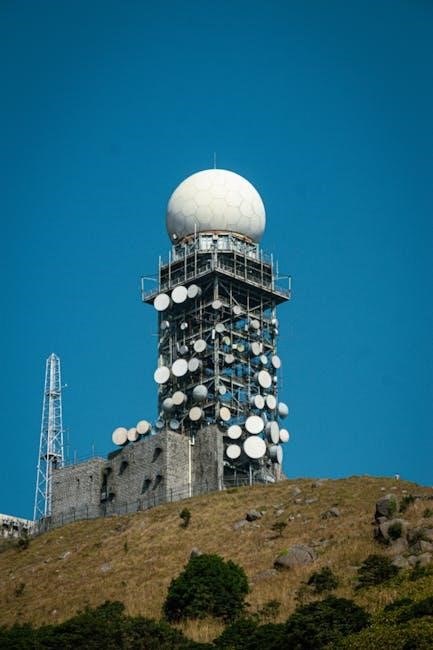Ground guiding signals play a crucial role in modern technology, enabling precise communication and navigation across space exploration, satellite operations, and terrestrial systems; They are essential for satellite ground stations, indoor navigation, and cosmic signal detection, ensuring accuracy and reliability in various applications.
1.1 Definition and Purpose
Ground guiding signals are specialized electromagnetic signals used to enable precise communication, navigation, and control in various technological systems. Their primary purpose is to provide accurate guidance, synchronization, and data transmission between ground-based infrastructure and mobile or remote systems, such as satellites, spacecraft, or terrestrial vehicles. These signals are essential for ensuring operational efficiency, safety, and reliability in applications ranging from satellite ground stations to indoor navigation systems and cosmic research.

1.2 Importance in Modern Technology
Ground guiding signals are vital in modern technology, enabling precise communication and navigation. They facilitate satellite operations, indoor navigation systems, and cosmic signal detection. For instance, in Xiongan, low-cost, high-precision navigation systems rely on these signals. Additionally, they support space exploration by detecting ancient microwave signals and aiding space-to-ground communication. Their role in the beverage alcohol industry highlights their versatility, providing data-driven insights. These signals are essential for advancing technology and solving complex challenges across industries.
Satellite Ground Station Facilities
Satellite ground stations are critical infrastructure for space communication, enabling data transmission between satellites and Earth; RBC Signals’ agreement with mu Space in Thailand highlights their expansion in Southeast Asia, supporting space exploration and satellite operations globally.
2.1 RBC Signals Agreement with mu Space
RBC Signals and mu Space entered a strategic collaboration in 2024 to develop satellite ground station facilities in Thailand and Southeast Asia. This partnership aims to enhance satellite communication capabilities, supporting space exploration and technology advancement. The agreement underscores RBC Signals’ commitment to expanding its global network, ensuring reliable ground guiding signals for satellite operations. This collaboration is pivotal for fostering innovation and strengthening the region’s space infrastructure.
2.2 Expansion in Thailand and Southeast Asia
RBC Signals’ agreement with mu Space and Advance Technology Co., Ltd. in Thailand highlights the region’s growing importance in satellite ground station facilities. This collaboration aims to enhance infrastructure and support satellite operations across Southeast Asia, addressing the increasing demand for reliable communication services.
The expansion underscores Thailand’s strategic location for satellite ground stations, enabling better connectivity and data transmission. This initiative is expected to bolster the region’s role in global space exploration and technology advancement, fostering economic growth and innovation.
2.3 Role of Ground Stations in Space Exploration
Ground stations are vital for space exploration, enabling communication between spacecraft and Earth. They facilitate data transmission, mission planning, and system monitoring. The collaboration between RBC Signals and mu Space in Thailand highlights their role in expanding satellite support infrastructure. These stations ensure seamless operations for satellites, aiding in navigation, telemetry, and command execution. Their reliability is crucial for advancing space technology and maintaining global connectivity in space missions.
Terrestrial Navigation Systems
Ground guiding signals enable precise indoor navigation in complex environments like Xiongan’s 380km tunnel network, providing low-cost, high-precision solutions for urban and industrial infrastructure.

3.1 Indoor Navigation in Xiongan’s Tunnel Network
In Xiongan’s 380km tunnel network, researchers developed a low-cost, high-precision indoor navigation system using ground guiding signals. This technology enhances accuracy in complex underground environments, ensuring efficient movement and safety. The system leverages terrestrial signals to provide real-time positioning, critical for urban planning and infrastructure management. Its success highlights the potential for similar applications in smart cities and industrial settings, revolutionizing navigation in challenging environments.
3.2 Low-Cost, High-Precision Technology
Researchers in Xiongan’s tunnel network have developed a low-cost, high-precision indoor navigation system using ground guiding signals. This breakthrough leverages terrestrial signals to achieve accurate positioning in complex underground environments, reducing reliance on expensive infrastructure;
The technology is scalable and cost-effective, making it suitable for urban and industrial applications. Its implementation enhances navigation in smart cities and logistics, demonstrating the versatility of ground guiding signals in modern systems.
3.3 Applications in Urban and Industrial Settings
Ground guiding signals are transforming urban and industrial environments by enabling precise navigation and data-driven decision-making. In cities, they enhance smart infrastructure, improving traffic management and public safety. Industries leverage these signals for optimized supply chain logistics, inventory tracking, and automated manufacturing processes. Additionally, they support environmental monitoring and energy management, fostering sustainable development. Their versatility and reliability make them indispensable in modern urban and industrial ecosystems, driving efficiency and innovation across sectors.
Cosmic Signal Detection
Scientists detected a 13-billion-year-old microwave signal from the Cosmic Dawn using Earth-based telescopes in Chile, marking a significant milestone in the CLASS project.

4.1 Detection of 13-Billion-Year-Old Microwave Signals
Scientists have detected 13-billion-year-old microwave signals from the Cosmic Dawn using Earth-based telescopes in Chile. This groundbreaking discovery provides insights into the universe’s origins, leveraging advanced ground-based technology to capture these ancient signals. The detection highlights the role of ground guiding signals in astrophysics, enabling researchers to study the early universe’s formation and evolution with unprecedented precision.
4.2 The CLASS Project and Its Contributions
The CLASS (Cosmology Large Angular Scale Survey) project has made significant contributions to astrophysics by detecting 13-billion-year-old microwave signals from the Cosmic Dawn. Using Earth-based telescopes in Chile, CLASS provides high-precision data, enhancing our understanding of the early universe’s formation. Its findings offer insights into the first stars and galaxies, shaping cosmological models and advancing signal detection technologies.
4.3 Implications for Astrophysics and Cosmology
The detection of 13-billion-year-old microwave signals from the Cosmic Dawn has profound implications for astrophysics and cosmology. These signals provide insights into the formation of the first stars and galaxies, reshaping our understanding of the early universe. The success of the CLASS project demonstrates the potential of ground-based telescopes in uncovering cosmic secrets, offering new avenues for studying the universe’s origins and structure formation.

Space Plane and Ground Station Communication
China’s space plane transmits signals to potential hidden ground stations or nearby ships, with amateur astronomers actively tracking these communications, revealing new dimensions in space-to-ground signal management.
5.1 China’s Space Plane and Signal Transmission
China’s space plane has been reportedly transmitting signals, potentially to hidden ground stations or ships near North America’s west coast. Amateur astronomers tracking the craft speculate about its communication methods, suggesting advanced signal transmission capabilities. This highlights China’s growing prowess in space technology and the importance of ground guiding signals in space exploration. The ability to maintain secure and precise communication underscores the role of ground stations in supporting space missions.

5.2 Amateur Astronomers’ Role in Tracking Signals
Amateur astronomers play a vital role in tracking signals from space planes and satellites, often uncovering unique insights. Their observations can detect unusual signal patterns, such as those from China’s space plane, potentially indicating communication with hidden ground stations. This grassroots involvement complements professional efforts, demonstrating how public engagement can enhance signal detection and space exploration. Their contributions highlight the collaborative nature of modern space technology and its far-reaching implications.
5.3 Potential Hidden Ground Stations
The possibility of hidden ground stations has emerged, particularly with China’s space plane reportedly transmitting signals to undisclosed locations. Amateur astronomers suggest these signals might be directed to covert ground stations or ships near North America’s west coast. Such hidden infrastructure could enhance security and operational flexibility, though it also raises concerns about unauthorized access and global surveillance. Detecting these stations remains challenging due to advanced signal encryption and strategic placement.
Ground Signal in the Beverage Alcohol Industry
Ground Signal’s Chain/National Program provides data-driven insights, helping the beverage alcohol industry track market trends and make informed decisions, enhancing business strategies and operational efficiency significantly.
6.1 Ground Signal’s Chain/National Program
Ground Signal’s Chain/National Program is a groundbreaking initiative launched in 2024, providing data-driven insights for the beverage alcohol industry. It leverages advanced analytics to track market trends, consumer preferences, and sales performance across the U.S.
This program enables businesses to make informed decisions by offering real-time data on product distribution, pricing, and competitive landscapes. Its launch underscores Ground Signal’s commitment to enhancing operational efficiency and market understanding in the beverage sector.
6.2 Data-Driven Insights for Market Trends
Ground Signal’s innovative platform provides real-time data analytics, transforming market trend analysis in the beverage alcohol industry. By leveraging advanced algorithms, it offers actionable insights into consumer preferences, sales patterns, and competitive landscapes.
This data-driven approach enables businesses to make informed decisions, optimize inventory, and enhance marketing strategies. Ground Signal’s tools are revolutionizing how companies adapt to market dynamics, ensuring they stay competitive in a rapidly evolving industry.
6.3 Impact on Business Decision-Making
Ground Signal’s data-driven insights revolutionize business decision-making in the beverage alcohol industry by providing real-time market trends and consumer behavior analysis. This enables companies to optimize inventory, pricing, and marketing strategies.
By leveraging predictive analytics, businesses can identify growth opportunities, reduce costs, and enhance operational efficiency. Such data empowers stakeholders to make informed decisions, driving competitive advantage and revenue growth in a dynamic market landscape.

Space-to-Ground Communication Alliances
Spaceflight Inc. and partners collaborate to enhance space-to-ground operations, with alliances like the Sherpa-LTE1 orbital tug advancing communication and propulsion systems for efficient space missions.
7.1 Sherpa-LTE1 Orbital Tug and Propulsion Systems
The Sherpa-LTE1 orbital tug, developed by Spaceflight Inc., represents a significant advancement in space-to-ground communication. Its propulsion system enables precise maneuvering of satellites and payloads, enhancing operational efficiency. This technology supports a range of missions, from satellite deployment to debris removal, while maintaining reliable communication with ground stations. The tug’s capabilities are integral to modern space operations, ensuring seamless connectivity and mission success.
7.2 Collaboration Between Spaceflight Inc. and Partners
Spaceflight Inc. has formed strategic alliances with key partners to enhance space-to-ground communication capabilities. Their collaboration focuses on advancing orbital tug technologies, such as the Sherpa-LTE1, to improve satellite deployment and maneuvering. By working together, these companies aim to streamline operations, reduce costs, and increase the efficiency of space missions. This partnership underscores the importance of teamwork in overcoming technical challenges and driving innovation in space exploration and satellite services.
7.3 Enhancing Space-to-Ground Operations
The collaboration between Spaceflight Inc. and its partners has significantly enhanced space-to-ground operations through advanced propulsion systems like the Sherpa-LTE1 orbital tug. This alliance streamlines satellite deployment, reduces operational costs, and improves mission efficiency. By leveraging shared expertise, these partnerships ensure reliable communication and navigation systems, enabling seamless data transmission between space and ground stations. Such innovations are pivotal for scaling space exploration and maintaining robust ground guiding signal networks globally.
Challenges in Ground Guiding Signal Technology
Signal interference, noise reduction, and security concerns pose significant challenges. Technological limitations require continuous innovation to enhance reliability and accuracy in ground guiding signal systems.
8.1 Signal Interference and Noise Reduction
Signal interference and noise reduction are critical challenges in ground guiding signal technology. Electromagnetic interference from nearby devices and physical barriers can disrupt signal clarity. Advanced filtering algorithms and adaptive signal processing techniques are employed to mitigate these issues. Researchers are exploring innovative materials and shielding methods to enhance signal integrity. Effective noise reduction ensures reliable communication in satellite operations, space exploration, and terrestrial navigation systems, maintaining accuracy and performance in diverse applications.
8.2 Security Concerns in Signal Transmission
Security concerns in signal transmission are critical, as ground guiding signals are vulnerable to interception and hacking. With increasing reliance on satellite communications, protecting data integrity is paramount. Encryption and secure protocols are essential to prevent unauthorized access, ensuring sensitive information remains confidential. Collaborative efforts between companies and cybersecurity experts are necessary to develop robust systems and mitigate risks in this evolving field.
8.3 Technological Limitations and Innovations
Ground guiding signals face challenges like signal interference and noise, which hinder accuracy. Security concerns also arise from potential data breaches. However, innovations such as quantum signal processing and AI integration are addressing these limitations, enhancing precision and reliability. These advancements are pivotal for overcoming technological barriers and ensuring robust performance in various applications, from space exploration to terrestrial navigation.

Future Trends in Ground Guiding Signals
Advancements in quantum signal processing and AI integration will enhance precision and security, while global ground station networks expand to support growing satellite and space exploration demands.
9.1 Advancements in Quantum Signal Processing
Quantum signal processing is revolutionizing ground guiding signals by enhancing precision and security. Leveraging quantum entanglement and advanced algorithms, this technology minimizes interference and optimizes data transmission. Recent breakthroughs enable faster processing of complex signals, improving navigation and communication systems. Integration with AI further boosts efficiency, paving the way for next-gen applications in space exploration and terrestrial networks. These advancements promise unparalleled accuracy and reliability, driving innovation across industries.
9.2 Integration with AI and Machine Learning
Ground guiding signals are being revolutionized by AI and machine learning, enabling smarter signal processing and predictive analytics. These technologies enhance pattern recognition, noise reduction, and real-time decision-making, improving the accuracy of satellite communications and terrestrial navigation systems. AI-driven algorithms optimize signal transmission, while machine learning predicts interference patterns, ensuring reliable data flow. This integration is transforming industries, from space exploration to urban navigation, by delivering faster and more precise ground guiding solutions.
9.3 Global Expansion of Ground Station Networks
The global expansion of ground station networks is revolutionizing space-to-ground communication, enabling seamless connectivity across vast distances. Companies like RBC Signals are leading this charge, collaborating with international partners to establish state-of-the-art facilities. This growth enhances signal coverage, supports diverse space missions, and fosters innovation in satellite operations. As ground stations proliferate worldwide, they pave the way for more efficient and reliable communication systems, driving advancements in space exploration and terrestrial applications alike.
Ground guiding signals have revolutionized communication, navigation, and space exploration, with advancements in satellite operations, indoor systems, and cosmic detection paving the way for future technological breakthroughs.

10.1 Summary of Key Developments
Recent advancements in ground guiding signals highlight significant progress in satellite communication, navigation, and cosmic exploration. RBC Signals’ partnership with mu Space in Thailand and the development of low-cost indoor navigation systems in Xiongan demonstrate technological innovation. The detection of ancient microwave signals by the CLASS project and China’s space plane signal transmissions showcase breakthroughs in space exploration. Collaborations like Sherpa-LTE1 and Ground Signal’s Chain/National Program underscore the growing importance of ground guiding signals in modern technology and industry.
10.2 Potential Impact on Future Technologies
Ground guiding signals will revolutionize future technologies by enhancing space exploration, satellite communication, and terrestrial navigation. Advances in signal processing and AI integration will enable faster and more accurate data transmission, driving global connectivity. Collaborations like RBC Signals and mu Space underscore the potential for expanded satellite networks, fostering innovation in industries from telecommunications to astrophysics. These developments promise to unlock new frontiers in technology, ensuring ground guiding signals remain pivotal in shaping tomorrow’s advancements.
